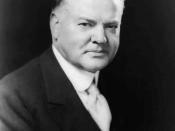Paul Krugman states that his goal is to develop a theory of how the currency panics of Asia spread around the world, and how to prevent this from happening again The Return of Depression Economics explains how the liquidity trap and currency panics experienced by the Asian and Latin American economies over the past decade resemble the Great Depression. Krugman cautions that we are not immune to the problems experienced by those economies, and that Japan's long economic slump could happen to America as well. This is because the traditional methods to fix economies are no longer enough to counter recessions.
Today, most economists regard the Great Depression as an unnecessary tragedy. Economists' wonder why the Federal Reserve didn't print more money, and the conservative President Herbert Hoover enact an expansionary fiscal policy. In truth, they didn't know better. they held to traditionally held views that the market would correct itself, and this was a short-run problem.
The New Deal and the WWII energized the economy, and pulled America out of its slump. It proved the worth of Keynesian economics.
In the 1990's, we thought that we could avoid the mistakes of President Hoover and the Federal Reserve, and that Depressions were never to be seen again. However, the currency panics and economic crisis's suffered beginning in 1997 resemble the events of the Great Depression. In fact, Japan has experienced a larger and longer stock market slump than America did in the Great Depression. Today, the Nikkei index is just 25% of it's 1989 high. Japan however is not the only economy to suffer in the 1990's. Mexico, Argentina, Brazil, Russia, Korea, and Thailand were among the many countries that saw their currencies devalued, and economies thrown into recession.
The basic premise to recessions is that supply...



Good..Well Developed
Its good...sources are stated...paragraphs fully developed...comparisons made effectively...review of literature good...
1 out of 1 people found this comment useful.